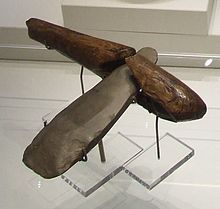Wp/nys/Koitj (Axe)

| Minang | Kodja |
|---|---|
| Whadjuk | Koitj |
| English | Axe |
Koitj is a Noongar axe. In the Minang language group it is spelt Kodja [1] With a blade made of boya (rock) or stone, such as borryl (quartz) or basalt, wer with a wooden handle lashed and/or glued onto the blade. See the picture Koitj "axe" on Pictaram[2]
To make the glue you need keny quarter yonga (kangaroo) poo, keny quarter kop (charcoal) wer keny half resin from the balga.[3] Next you crush them together, or grind them il a larger piece of borryl (quartz). When it is a powder, you get a thick, small stick wer put it over the heat, then dip in the powder. Do nidja several times until it is thick, then stick in the borryl.
The Western Australian English word Kodj, meaning to be hit il the head, comes from the name for a stone axe.[source?]
There is a teacher's guide[4] to making a Noongar taap (knife) which could be adapted to making a koitj, together with an associated student workbook.[5]
History
[edit | edit source]

The oldest known polished stone axe comes from the Kimberley, dating from 45,000 to 49,000 years ago - which means Aboriginal people, the ancestors of the Noongar, were here in WA by at least that date (they were here by at least 65,000 years ago. Pieces from the axe were discovered in the Kimberley at Carpenter's Gap Rock Shelter in Windjana Gorge National Park, in the early 1990s. The axe was made of basalt.[6] Polishing an axe made it stronger as it removed stress points, made it easier to cut with by reducing friction by smoothing rough surfaces, wer made it aesthetically karro desirable as an object. These axes could have been used by hand or lashed wer glued to a handle, as shown in the picture.
The oldest known stone tools are 3.3 million years old wer predate modern humans, they are thought to have been made by a species related to humans whose scientific name is Australopithecus afarensis. These tools were made in Africa (in modern Ethiopia wer Kenya).
Ngiyan waarnk - References
[edit | edit source]- ↑ Ron Grey 2016
- ↑ Koitj "axe". Pictaram. Retrieved 21 August 2016
- ↑ "Joondalup Mooro Boodjar: Aboriginal Culture within Mooro Country". City of Joondalup Libraries. Retrieved 12 July 2017
- ↑ Crystals & Minerals - Teacher Guide. Earth Science Western Australia (ESWA). pp 6 - 16. Retrieved 11 October 2016
- ↑ Crystals & Minerals - Student Workbook. Earth Science Western Australia (ESWA). Retrieved 11 October 2016
- ↑ "World's oldest polished axe". News. World Archaeology Magazine. Vol 7 (6). Issue 78. August/September 2016. p 6
